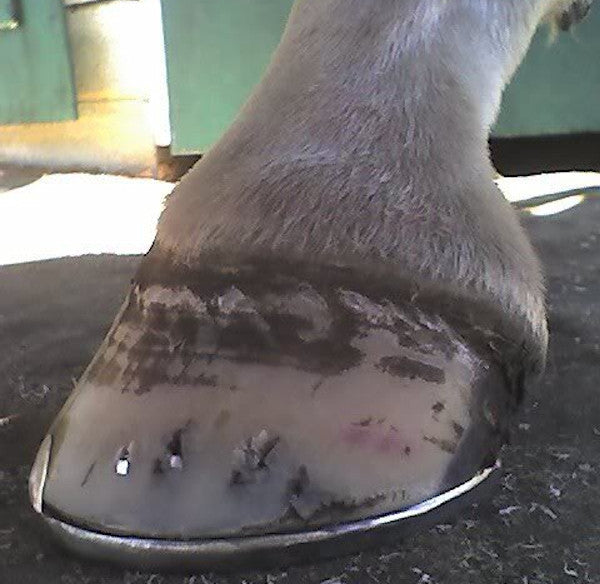
Why NOT to Rasp the Entire Hoofwall
Share
The periople lies just under the coronary band/hairline of the hoof capsule.
Its role is to protect the softer new horn that is being generated to grow new hoofwall.

The rest of the wall of the hoof is protected by a thin layer of tissue that protects it from outside environmental insults. (You can see just part of this covering on the hoof above - and can clearly see where the hoof protection has been rasped away.)
When this protective covering is damaged in some way, i.e., rasping the entire wall of the hoof, then these outside factors will damage the hoof. This covering also helps to control evaporation of moisture from the wall.
The hoof wall is made of a tough material of keratinized protein that has a low moisture content (approximately 25% water), making it very hard and rough.
In the palmar/plantar part of the hoof, the periople is thicker and more rubbery over the heels, and it merges with frog material. Not all horses have the same amount of periople.
Many times we see the hoofwall is rasped or filed from the coronary band down to the ground. While it may make the hoofwall more pleasing to the eye, this treatment weakens and thins the wall as well as destroys the protective properties that help to balance the moisture of the hoof. My general rule of thumb is, when needed, rasp no more than 1/3 up the hoofwall and no more than 1/3 the thickness of the wall.
Dry hooves tend not to have much periople and the protective covering of the wall is also absent. Many use hoof oils and dressings to help moisturize the hoofwall but most of these have been found to be totally ineffective and may even cause damage.
Susan Kempson, BSc, PhD, senior lecturer in Preclinical Veterinary Sciences in the Royal (Dick) School of Veterinary Studies at the University of Edinburgh, have studied environmental effects and the efficacy of hoof dressings on hooves. Her findings were as such, "
"Heat, cold, and water had no effect on the permeability barrier. The sole and frog horn left in feces for two weeks disintegrated, and poor-quality wall horn was also badly affected. Good-quality wall horn was only marginally changed. Urine alone had little effect, but combining urine and feces had the same results as feces alone.
"My conclusion is that the horn has a built-in permeability barrier," she says. "As long as the horse has a well-balanced diet so that he can produce good-quality horn, leave the hoof horn to look after itself."

With regard to hoof dressings ...
"Poor-quality horn treated with formalin thus becomes more susceptible to infectious and toxic agents, and therefore this chemical is best avoided.
The study also showed that hoof dressings containing solvents and tar-based components damaged poor-quality horn. In some cases, the intercellular lipids or fats were damaged, allowing water contained within the horn to evaporate, thus causing the horn to become dry and brittle. In very wet conditions, using these hoof dressings allows water into the horn, and the feet become very soft and weak.
"When these products were applied to poor-quality horn, the damage was magnified, and I could not get results from some of the tissues because they had disintegrated in the test solutions. ...
It was also clear that the majority of the dressings that horse owners applied to the hoof capsule did much more harm than good. Most are unaware of what they are doing to their horse's feet. They apply the dressings with the best of intentions, but more research needs to be done to clarify the situation."
Hopefully this information will cause some to pause before rasping the entire hoof wall of their horses' hooves or those of their clients for aesthetic reasons.
A good practitioner and caretaker of equine hooves would be wise to follow the Drs. oath of "First, do no harm."
Building a Supportive Barefoot Community
The team at Scoot Boot believe passionately in the barefoot horse and strive to build a supportive community of barefoot horse lovers.
Find more information about using Scoot Boots here.

Gwen Santagate is the author of "10 Secrets to Healthy Hooves" . For the last 37+ years, she has maintained healthy hooves with natural trimming on thousands of horses and specialized in pathological rehabilitation hoofcare for the last 18 years. She keeps a small herd of her own equines and continues to offer consults for horses in need.

